Key takeaways:
- Understanding key health insurance terms—premiums, deductibles, copayments, and provider networks—is crucial to avoid confusion and ensure proper coverage.
- Evaluating personal health needs, including the frequency of doctor visits and medication requirements, helps in selecting the right insurance plan.
- Maximizing insurance benefits involves utilizing preventive care services, verifying in-network providers, and staying informed about policy details.
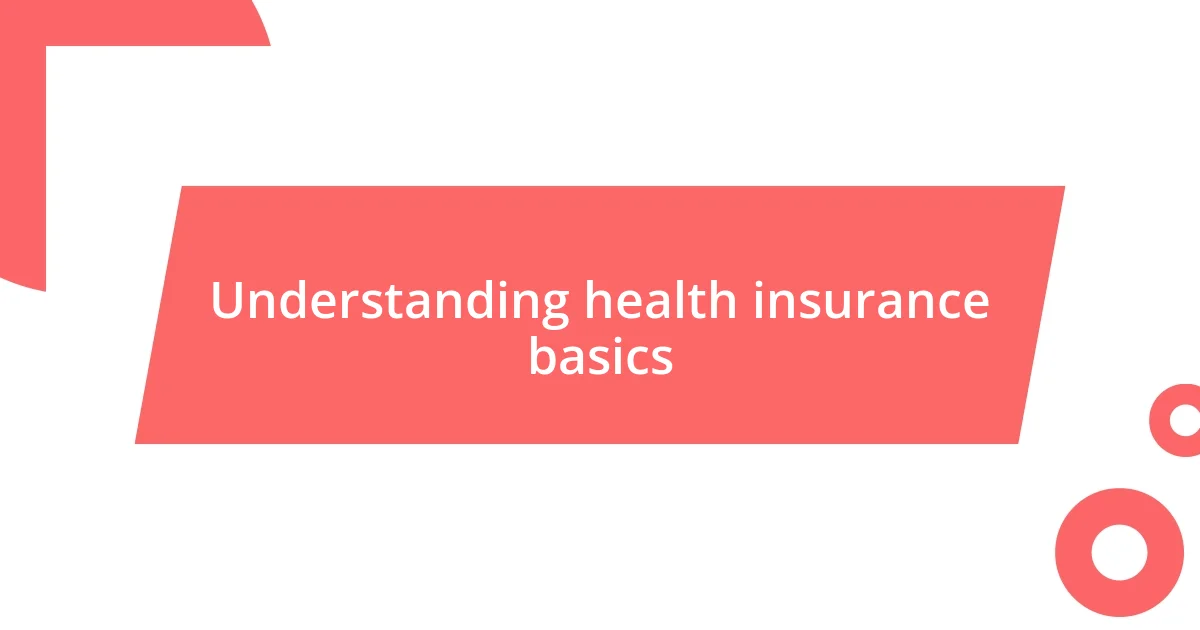
Understanding health insurance basics
Understanding the basics of health insurance can sometimes feel overwhelming, but it’s essential to grasp a few key concepts. For instance, terms like premiums, deductibles, and copayments are fundamental. I remember the first time I encountered these terms; it felt like learning a new language! Have you ever found yourself confused by all the jargon? You’re definitely not alone.
Premiums are essentially the monthly fees you pay to maintain your health insurance coverage, kind of like a subscription service. I vividly recall postponing a doctor’s visit because I was uncertain about my deductible—the amount I had to spend out-of-pocket before my insurance kicked in. It left me questioning whether I was really protected. It’s vital to understand how these elements work together, so you’re not caught off guard when medical needs arise.
Another vital aspect is the network of providers included in your plan. Choosing a plan often requires evaluating whether your trusted doctors are part of that network. I once switched providers to save on my premium, only to find out that my long-time physician wasn’t included. Talk about a hard lesson! Have you looked into your options thoroughly to avoid any last-minute surprises? Understanding network coverage can save you time, money, and a whole lot of headache.
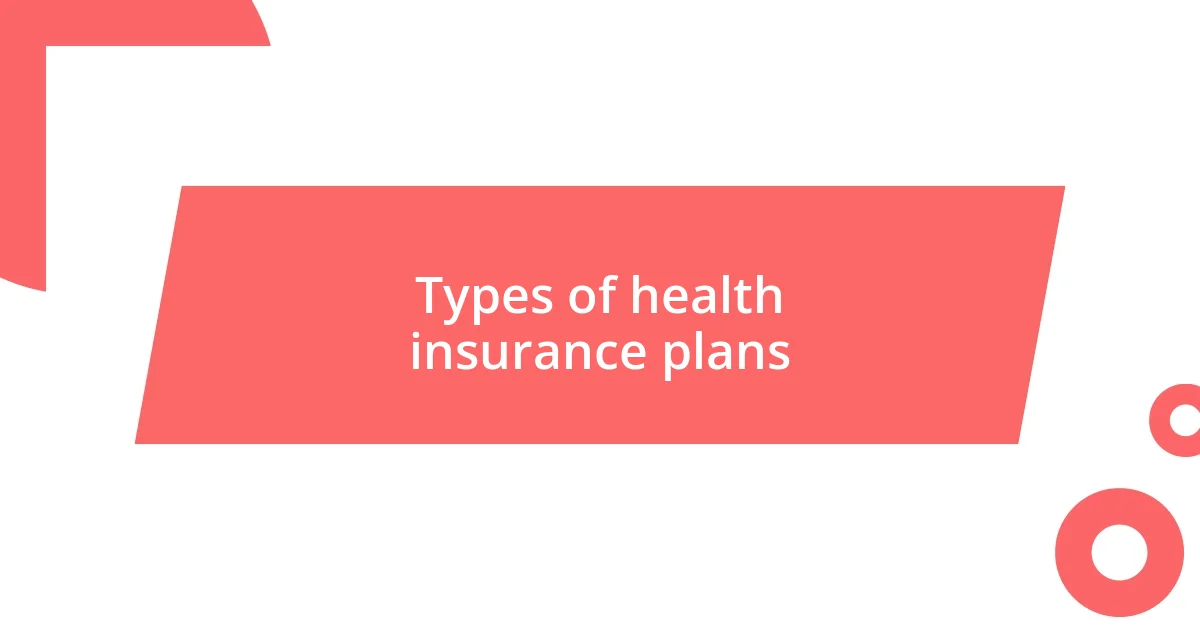
Types of health insurance plans
When exploring types of health insurance plans, it’s crucial to understand the basics of each option available. For instance, I’ve found that Health Maintenance Organizations (HMOs) often offer lower premiums but require you to choose a primary care physician. This arrangement means you may need referrals for specialists, which could be a hassle if you require immediate care. I remember feeling frustrated when I had a skin issue and had to wait for a referral that felt unnecessary. Have you ever faced similar challenges?
On the other hand, Preferred Provider Organizations (PPOs) provide more flexibility. They allow you to see any doctor without a referral, although staying within their network can save you money. I personally like the freedom to choose my healthcare providers without jumping through hoops. However, this luxury comes with higher premiums. Balancing convenience with cost can be tricky; it often feels like a guessing game no one wants to play!
Lastly, High Deductible Health Plans (HDHPs) paired with Health Savings Accounts (HSAs) are worth considering. They typically have lower premiums but higher deductibles, which can be daunting for some. I had one of these plans, and while it encouraged me to save for medical expenses, I sometimes struggled to cover costs before my insurance kicked in. Have you thought about how much risk you’re willing to take on? Each type of plan has its own set of pros and cons, and evaluating them based on your health needs is essential.
| Health Plan Type | Key Features |
|---|---|
| HMO | Lower premiums, requires referrals, in-network care only |
| PPO | More flexibility, no referrals needed, higher premiums |
| HDHP with HSA | Lower premiums, high deductibles, savings for future medical expenses |
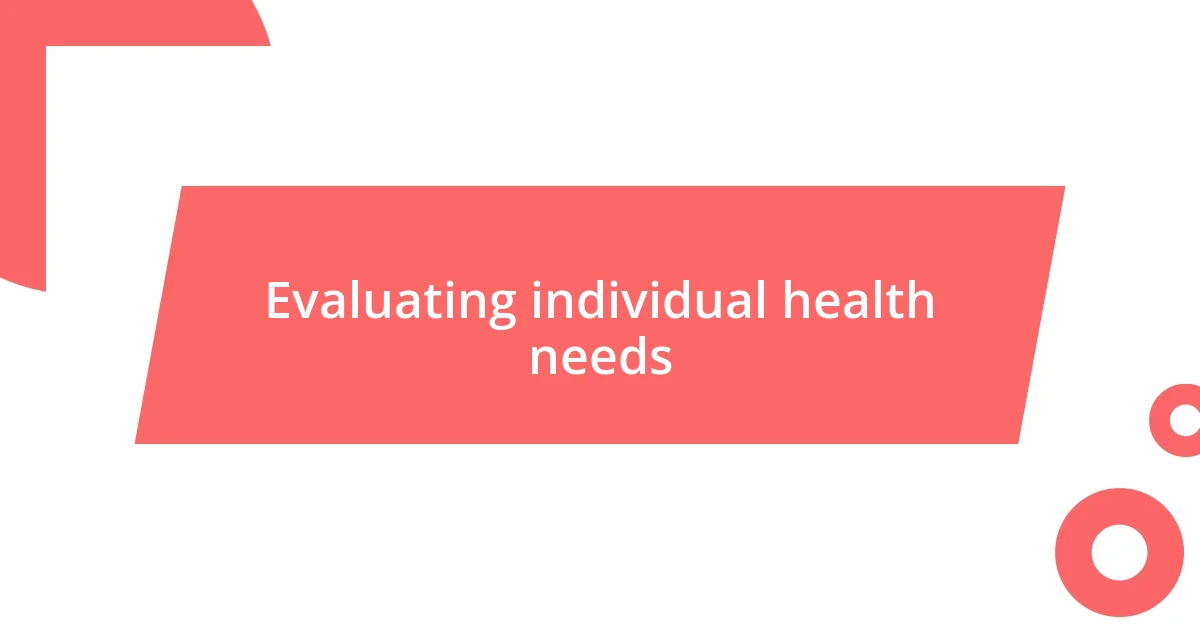
Evaluating individual health needs
Evaluating your individual health needs is a critical step in selecting the right health insurance. I find it helpful to reflect on my own health history and the kind of medical care I typically require. For instance, I noticed that I visit my doctor for routine check-ups regularly, but I also tend to face seasonal allergies that need occasional medication. This is how I began to recognize the importance of a plan that covers prescriptions and preventive care, allowing me to maintain my well-being without financial strain.
Here are some essential factors to consider when assessing your health needs:
- Frequency of doctor visits: Do you go for regular check-ups or specialist appointments?
- Chronic conditions: Do you have any long-term health issues that require ongoing treatment?
- Medication needs: Are you taking any medications that might significantly impact overall costs?
- Preventive care: How important is it to you that your insurance covers preventive services like vaccinations and screenings?
- Family health history: Acknowledge any hereditary conditions that could influence your future healthcare needs.
By weighing these elements, you can make a more informed decision about your insurance options. Reflecting on my personal health experiences has taught me that a tailored approach to choosing insurance can ultimately save you both time and money.
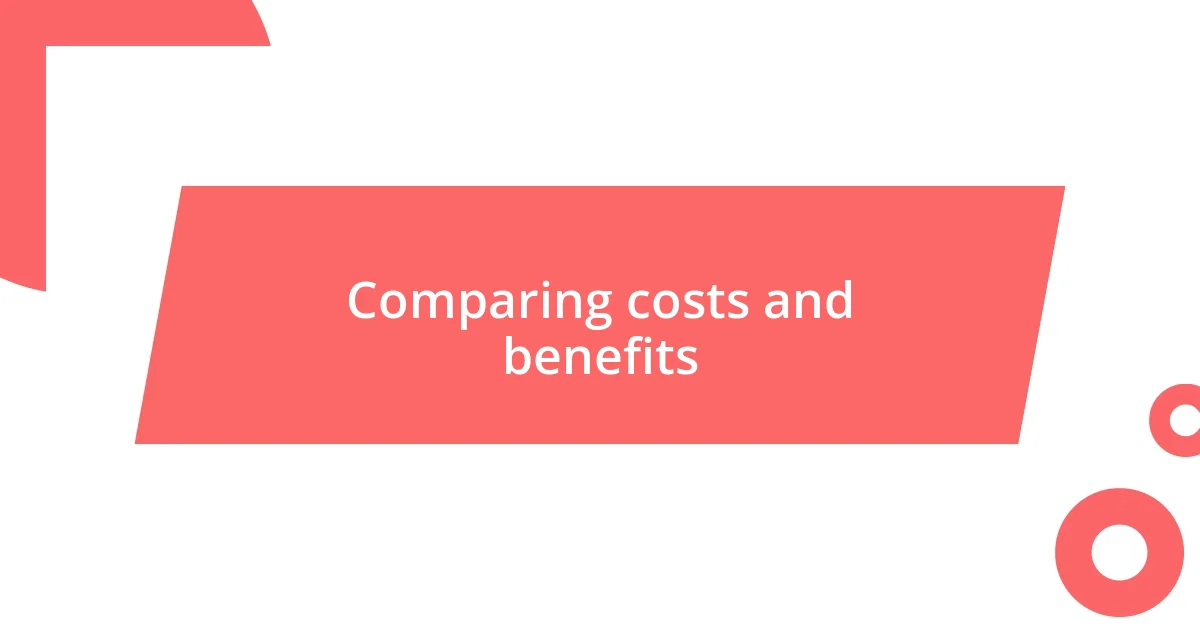
Comparing costs and benefits
When comparing costs and benefits, it’s essential to evaluate not just the premium amounts but what’s covered under each plan. I remember switching from a PPO to an HMO and feeling overwhelmed by the referral system. Initially, I felt I saved money, but the numerous referrals needed for specialists made me question if the savings were worth the hassle. Have you ever regretted a decision like that?
Another aspect to consider is out-of-pocket expenses versus potential benefits. I experienced this firsthand when I chose a plan with a lower premium but high deductibles. While my monthly payments were manageable, I often found myself stressed about how much I’d have to pay out before my insurance kicked in, particularly when an unexpected medical expense arose. It’s all about finding the balance that makes sense for your own financial situation, isn’t it?
Lastly, I believe it’s crucial to think about the long-term implications of your choices. I’ve observed that while some plans offer lower costs upfront, they can lead to larger expenses if you frequently need care. A friend of mine opted for a seemingly budget-friendly plan but ended up paying significantly more in co-pays because she saw specialists regularly. This taught me that an upwardly rising total cost might be hidden behind those shiny low premiums! Have you taken the time to assess your long-term health needs against the cost of insurance?
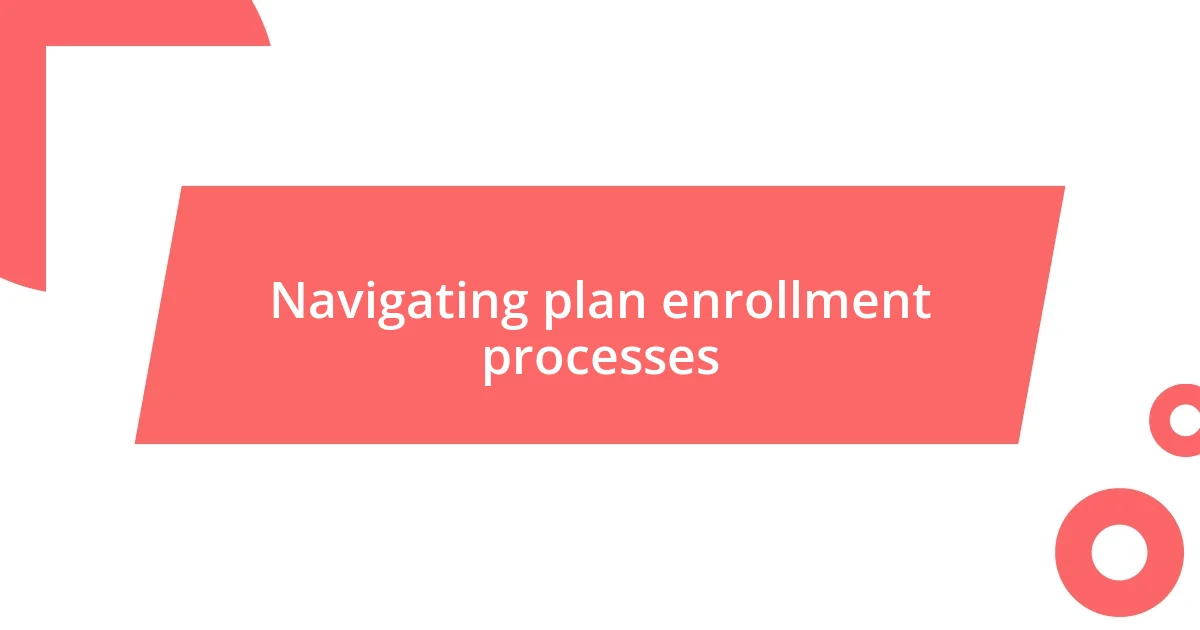
Navigating plan enrollment processes
Navigating the enrollment process for health insurance can feel daunting. I remember feeling overwhelmed when I first signed up for my plan. The sheer amount of information was a lot to digest, from application forms to deadlines. Have you ever looked at a stack of paperwork and just thought, “Where do I even start?” It’s important to take a deep breath and break it down step by step.
One of the things that helped me was creating a checklist of required documents and steps. I noted items like proof of income, identification, and any necessary medical records. By organizing everything in advance, I found that I could approach the enrollment process with confidence. It’s like planning for a trip—having the right documents ready makes all the difference, doesn’t it?
Additionally, I found it beneficial to familiarize myself with key terms and processes, such as open enrollment periods. Missing those windows can lead to a year with the wrong plan. Once, I almost let that happen and realized how critical it is to mark those dates on your calendar. Understanding the timeline can ensure you don’t miss out on getting the coverage you need when the time comes. Have you considered setting reminders for important deadlines?
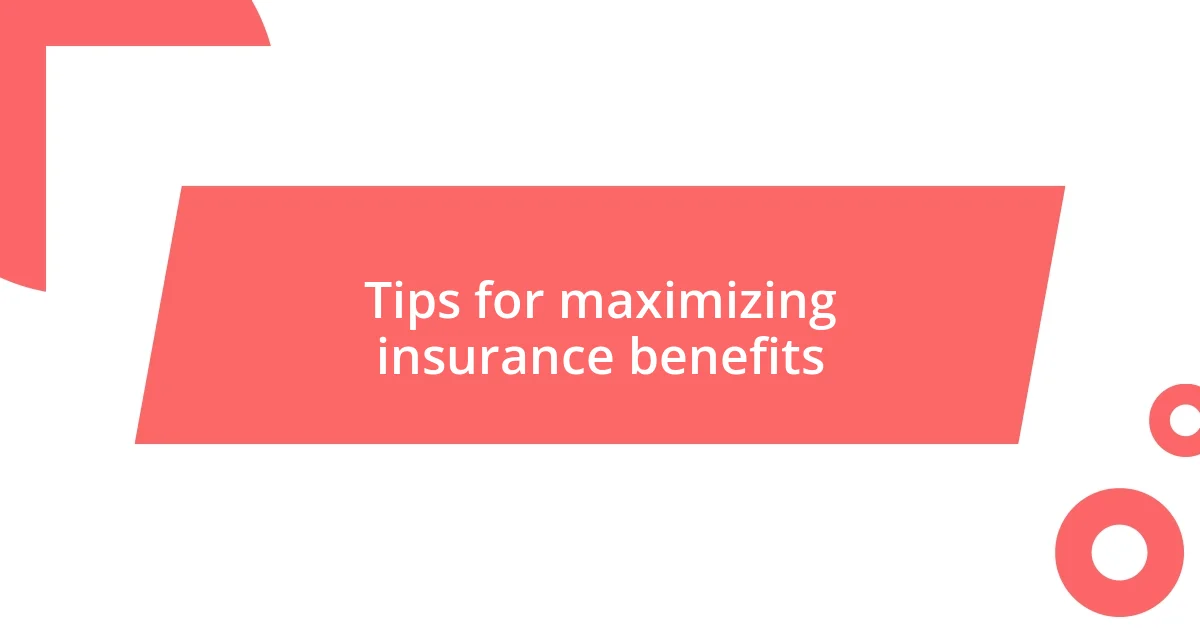
Tips for maximizing insurance benefits
One of the best ways to maximize your insurance benefits is by utilizing preventive care services. I remember the relief I felt after finally scheduling a routine check-up. It’s amazing how many services, like vaccinations and screenings, are covered at no cost. Have you taken advantage of these benefits? By prioritizing preventive care, you can catch potential health issues early, which not only improves your health but can also save you money in the long run.
Additionally, I’ve learned the importance of understanding your plan’s network. The first time I went to an out-of-network provider, I quickly realized how costly it could be. Checking if your preferred doctors and specialists are in-network can significantly lower your costs. Have you verified the list of providers? Knowing this can not only help you avoid unexpected bills but also ensure you’re using the insurance benefits to their full potential.
Lastly, always stay informed about your policy’s details. I once missed a valuable coverage option for physical therapy because I wasn’t fully aware of my plan’s features. I now make it a point to review my benefits each year, and it’s really transformed my approach to managing health expenses. How often do you revisit your insurance plan? Taking the time to understand what’s offered can empower you to make the most beneficial healthcare decisions for yourself.














